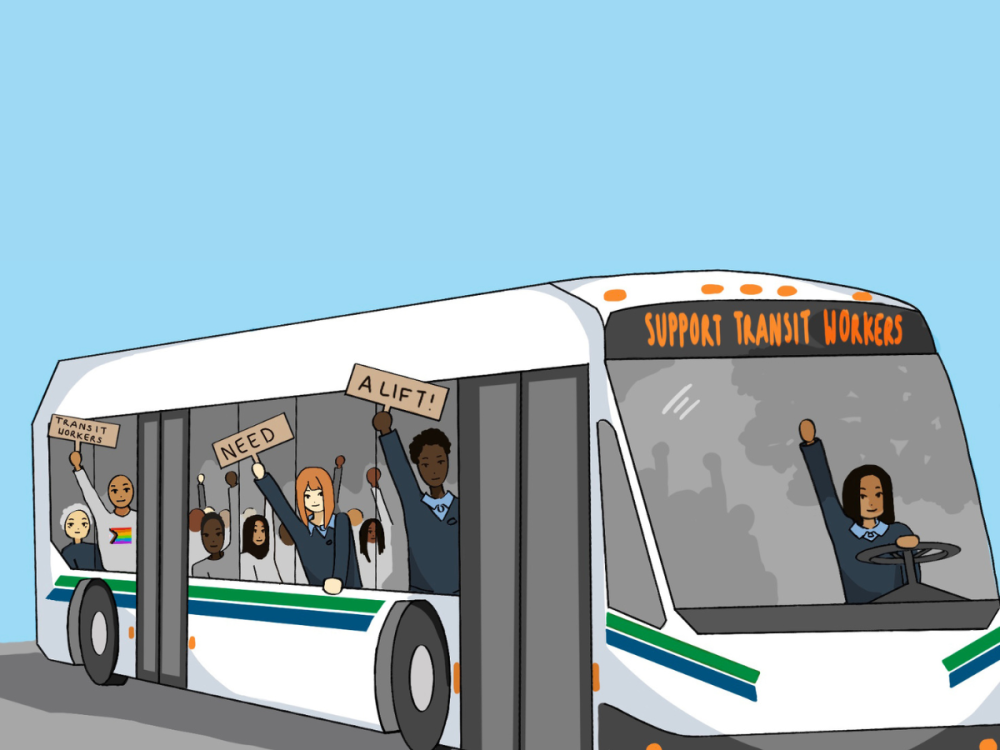It's busy; it's fulfilling; it's a solid union job. When I applied as a transit driver, what immediately appealed to me was the idea of a reliable paycheque plus benefits — things that would provide me with the ability to have a decent quality of life. What also called out to me, though, and this may sound a little utopian, was the opportunity to provide a fundamental service that helps my community flow: I would be transporting other workers to work and shuttling kids to school, ferrying families to the pool and people around town getting their errands done — the thousands of everyday little threads that, when woven together, contribute to the larger organic tapestry we call community.
Yes, the job can be hard; there is no dancing around social reality. There are the teenagers vandalizing the seats in the back. There are the rowdy university students openly drinking with no regard for the people around them. A man walks on and is upset that you are late. An impaired person has a strange story about where their bus pass has disappeared to. And suddenly, Whoa! A pick-up truck has just cut in front of you to make a right turn that is blocked by pedestrians. An expletive is yelled at you from the back to go easy on the brakes. The pick-up driver is holding his middle finger out the window. Yeah, no big deal. Water off a duck’s back.
I remain positive, and I still love the job. Maintaining a positive attitude almost becomes an act of defiance. A way to make each shift more human. Beyond the stress, there are still the countless people who make it all worthwhile. You continue driving on regardless of frustration, insult, or close call because you are doing your part for this beautiful community as it is at street level.
What can make it exceedingly tough, though, are certain conditions that unnecessarily hinder your capacity to do your job. As you drive, you steadily fall behind. The amount of time you are given to drive your route does not correspond to the actual time needed to negotiate traffic congestion or to give the many people boarding your bus the time they need to get on and off. People are frustrated that they've done their due diligence and looked up the bus schedule, only to have the bus show up several minutes late. You get to your terminus and have just a few short moments before you need to be back in the seat driving your next route.
Maybe you'll get more time at your next terminus — hopefully enough to wolf down some lunch. Ten minutes would be nice, 15 would be ideal. You find yourself counting exactly how many minutes it takes to go to the washroom and how many minutes it takes to eat your lunch. Lunch that will most likely be spread over a few hours. Everything is timed to the minute.
Yes, it's part of the job, but it would be nice to be given the proper amount of time to do the job you are asked to do. Needless to say, the time allocated to drive a route, as well as the layover time between routes, has an impact on your interactions with passengers, the interactions between passengers, and the safety of every passenger.
Also significant is the structure of the shifts. Not just those early mornings and late nights, but certain conditions that seem to directly contravene the very notion of the eight-hour work day. Split shifts, those where your first segment and second segment are separated by an unpaid gap, can stretch your day so it becomes a 12-hour one. Erratic shifts in your first few years of service, particularly on the “spareboard” (when you serve as a backup driver who steps in if a regular driver is away) are too often scheduled with only eight hours of rest between them. What this translates to is working without a proper night’s sleep. You finish your shift at 11 p.m., for example, drive home, sleep, and then drive back to work for 7 a.m. Yes, all human beings have to improvise and adapt, of course, and we certainly do. Nobody likes a complainer.
But the question needs to be asked: Why? Who benefits exactly? Transit operators are asked to do a job, and they do it. Tight run times with minimal layovers unnecessarily turn up the pressure. Long days due to split shifts significantly erode one's work-life balance. Playing with proper sleep time is a straight-up affront to safety.
These conditions are not immutable. They are not things that simply “are.” They are conditions that can be fixed. They not only add to the stress of the job but directly compromise the transit service itself. Buses are late, drivers are stressed, or buses are simply missing because of staffing shortages. No one wants to be paid a bottom-rate starting wage to work under such conditions. Even at a top-rate senior wage, transit workers start to seriously think to themselves, “what is the point?”
As I am writing this, these conditions, and the questions they provoke, are playing out in real time. Transit operators in the Abbotsford area of British Columbia, our CUPE 561 union siblings, have taken a stand against these conditions being imposed upon them.
As transit workers, we serve the community, and we are part of the community. As CUPE 561 walks the line for better work conditions, we must remind ourselves that our work conditions are not beyond our control. If we are to have a vibrant community effectively connected by transit, then transit workers need to have the tools to in fact make this happen. We love our jobs and we love our community. That's why we work, and that is why, sometimes, we need to fight.
* Johannes Joachim is a pseudonym. Joachim is a Unifor transit operator who has been serving his community for the last 15 years. He has driven taxi on the night shift and Class 1 fuel trucks at the airport. Whether reading or hiking, writing or supporting a picket line, he believes it is together as rank-and-file workers that we can shape our future.











